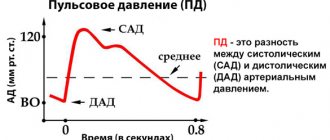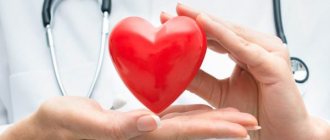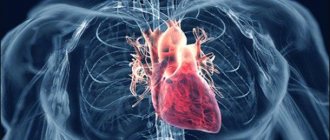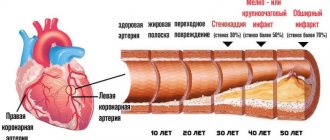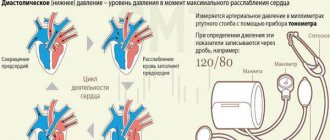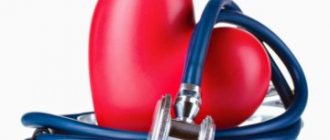Examination and treatment tactics
Every cardiologist knows how to lower upper blood pressure. It is necessary to find out the cause of hypertension. For this purpose the following studies are carried out:
- general clinical tests;
- angiography;
- Ultrasound of the heart, kidneys and adrenal glands;
- biochemical research;
- blood test for hormones;
- electrocardiography;
- blood pressure measurement;
- CT scan.
If you have hypertension, you need to change your lifestyle. The doctor should tell the patient how to reduce blood pressure at home. The following rules must be observed:
//www.youtube.com/watch?v=I7E1RJSbYXE
- adhere to a diet with limited intake of salt and animal fats;
- give up alcohol;
- quit smoking;
- do psychological relief;
- move more.
The causes and treatment of systolic hypertension are related. You need to get rid of the underlying disease. Pheochromocytoma and high lower blood pressure require surgery. During crises, a medicine from the group of beta-blockers (Metoprolol) is prescribed. For glomerulonephritis, diet No. 7 is indicated. Glucocorticoids, antibiotics, NSAIDs and tablets that suppress immune reactions (Imuran) are prescribed.
Reducing blood pressure against the background of impaired renal blood flow is possible surgically. In this case, tablets are ineffective. Not everyone knows how to lower lower and upper blood pressure against the background of hypertension. Most often, such people are prescribed a drug from the group of ACE inhibitors (Capoten, Captopril-Akos, Prestarium, Perindopril-SZ).
Very often, systolic blood pressure is elevated due to atherosclerosis. Such patients are prescribed statins. A blood pressure-lowering drug is often combined with antiplatelet agents. The latter reduce the risk of thrombosis. If the drug therapy does not improve, you can increase the dosage and change the drug, but only after consulting a doctor. Systolic blood pressure can increase in a variety of diseases.
ethnoscience
How to reduce upper blood pressure using folk methods?
To get rid of the symptoms of hypertension at home, an infusion of chokeberry and lingonberry is made. To prepare it you will need 1 teaspoon of fresh berries mixed with one glass of water. The resulting infusion is drunk once a day, a glass, for two weeks.
Also especially popular is a tincture made from a herbal mixture of five plants. It includes 100 ml of peony tincture, motherwort, eucalyptus, valerian, and 25 ml of mint. Clove inflorescences (10 pcs) are added to the resulting grass mixture, which are first allowed to settle for 15 days in a dark place. The finished mixture must not be shaken.
The resulting tincture should be used three times a day, one dessert spoon 15 minutes before meals. The course of treatment is one month, rest between courses is at least 10 days.
Treatment of high blood pressure
Enter your pressure
130
on
90
Search in progress Not found
If a patient has high blood pressure, the doctor will conduct an examination, including measuring:
- body mass index;
- blood cholesterol levels, etc.
The first thing you need to do to try to lower your blood pressure is to change your lifestyle.
- proper nutrition;
- giving up bad habits;
- taking vitamins;
- avoiding stressful situations.
If a person has very high blood pressure, then measures to reduce it must be taken urgently.
If you have systolic hypertension, there are a number of tips for changing your lifestyle:
- Changing your nutritional diet. Reduce blood pressure by 8-14 mmHg. Art. Following a diet consisting of vegetables, fruits, and low-fat dairy products will help. In addition, you need to limit your intake of unsaturated and saturated fats.
- Limiting salt intake. If you reduce the consumption of this product by 6 grams every day, then your upper blood pressure can be reduced by 2-8 mmHg.
- Loss of body weight. Reduce systolic pressure by approximately 1 mmHg. Art. Every kilogram you lose will help.
- Limiting the consumption of alcoholic beverages.
- Physical activity. At 4-9 mmHg. Art. Upper pressure will decrease by walking in the fresh air for 30 minutes. Walking, running, swimming, dancing benefit the body, dilate blood vessels, increase blood flow, thereby reducing blood pressure.
If it is not possible to cope with systolic hypertension with the help of a healthy lifestyle, then the doctor prescribes antihypertensive medications to the patient. In the presence of a mild form of the disease, as well as if there are no serious concomitant diseases, thiazide diuretics are mainly used. They help remove excess sodium and water from the body.
Periodic cleansing of blood vessels is beneficial. In this case, garlic and lemon-garlic tinctures help quite well. The course conducted with her help will help:
- improve well-being;
- facilitate the work of the heart and blood vessels;
- make blood vessels elastic;
- eliminate sclerotic plaques leading to vasoconstriction.
You need to know that in many cases, proper nutrition, rest, and sleep will help bring your upper blood pressure back to normal, without the need for medications.
Home methods
At home, the following methods are used:
- proper rest: pressure often arises due to stress or extreme fatigue. The best thing to do in such a situation is rest. The patient needs to relax and sleep for a few hours. If this is not possible, walk in the fresh air;
- breathing: needs to be stabilized in order to calm down faster. Remember: inhale twice as slow as exhale;
- mustard plaster: People with sensitive skin and intolerance to mustard should not use this method. If there are no contraindications, take mustard plaster and place it on your neck as close to the back of the head as possible. Due to the irritating effect, blood vessels dilate and pressure decreases;
- vinegar: applied to a cloth and used as a compress on the soles. After 10-15 minutes, mild relief usually occurs;
- cold effect: tones the nervous system, so a contrast shower or hand and foot baths with cool water will help stabilize blood pressure;
- heat: dilates blood vessels, so when the levels are elevated, take a bath. But the water should not be hot, so as not to cause additional stress on the heart. Improve the effect by adding infusions with soothing herbs or special salts.
At your appointment, your doctor will tell you how to lower your upper systolic blood pressure through lifestyle changes. In some cases, this is enough to get better. If the indicators remain stable, then treatment is supplemented with medications and other methods of therapy.
To correct your lifestyle you will need to follow these rules:
- reduce the amount of salt in the diet: no more than 0.5 tsp per day is allowed. If the patient has serious kidney problems, then it is better to avoid it altogether in order to avoid increased blood pressure and swelling due to moisture retention in the body. A person already receives it with various products in the right quantity;
- giving up bad habits: alcohol and cigarettes have a negative effect on the cardiovascular system, so reduce their consumption to a minimum or completely eliminate them;
- relaxation of the nervous system: many hypertensive patients experience stress and overload in everyday life. In such cases, various plant-based alcohol tinctures help: motherwort, hawthorn, peppermint, valerian, lemon balm. They are bought or prepared. Useful are drugs that include several herbal components at the same time (“Novopassit” and “Sedevit”). There are usually no side effects, but sometimes mild drowsiness occurs. A holiday at sea or in any other calm place will help to relax an irritated nervous system;
- cleaning blood vessels: over the years, a person develops atherosclerosis due to hypertension, a poorly designed diet, abuse of bad habits, obesity, and a sedentary lifestyle. The disease is characterized by the appearance of atherosclerotic plaques, consisting mainly of low-density cholesterol. Gradually they block the lumen in the vessels and provoke an increase in upper pressure. You can get rid of them by adjusting your diet, playing sports and taking medications from the statin group (Lovastatin, Atorvastatin, Rosuvastatin);
- removal of excess fluid: this is done with the help of diuretics, infusions of herbs with a diuretic effect - bearberry, dill, knotweed. After all, due to excess water in the body, blood pressure and stress on the heart increase;
- weight loss: obesity increases blood pressure, so by losing 10 kg, you can reduce it by about 10 mmHg. Art.;
- playing sports: it is necessary to lead an active lifestyle. Aerobic exercise is especially beneficial for the cardiovascular system. It is recommended to run and go to the pool.
You can lower systolic blood pressure with breathing exercises. It helps reduce the production of adrenaline and relax the nervous system. Against this background, the intensity of heart contractions decreases, and pressure returns to normal.
Good results are achieved through this exercise:
- stand on your feet, bending your elbows and pointing your palms forward;
- clench your hands into fists and take short breaths through your nose;
- repeat four times and lower the upper limbs;
- take a 10-15 second break and repeat the exercise;
- the effect is usually visible on the fifth or sixth approach.
If your head is splitting and your upper blood pressure has risen greatly, you need to lie down and try to relax. Next, take a deep and slow breath, and hold for five to six seconds as you exhale. Perform the exercise for approximately four minutes. If necessary, it is repeated after a two-minute break.
Certain drinks and juices can slightly reduce systolic blood pressure and stabilize a person’s condition. If they are combined with medications, the effect is even better. Drinks useful for hypertension:
- dairy products: improves human well-being with a high concentration of calcium, which normalizes blood pressure. It is better to choose products with a lower percentage of fat content, since they contain more of this element;
- beet juice: due to nitrates, it helps improve blood flow and has a beneficial effect on the body as a whole. You need to drink 0.5 liters per day;
- Hibiscus: Many people drink this tea because of its wonderful aroma and pleasant taste. However, it is also a natural ACE inhibitor. It is consumed two to three cups a day to stabilize blood pressure;
- cranberry juice: helps dilate blood vessels and saturates the body with ascorbic acid. Drink two cups a day.
Treatment
To lower cardiac blood pressure, you need to take special medications. But drug treatment must also be supplemented with a correct lifestyle:
- traditional and non-traditional methods of relaxation (baths, massage, meditation, yoga, etc.);
- regular walks in the fresh air;
- exclusion of stressful conditions;
- proper rest and sleep.
It is also useful to do special gymnastics.
It is worth noting that treatment of high blood pressure must be carried out according to a certain scheme. So, blood pressure is reduced gradually (initially by 10-15%, later by 30%).
In hypertensive patients over 60 years of age, the levels can be brought down to the required levels in a few weeks or months. After all, a rapid decrease in blood pressure can lead to brain or kidney failure.
Thus, medications should initially be taken in small doses - ½ the normal dosage of the drug. This will allow the patient to adapt and minimize the impact of side effects.
In addition, medications must be selected individually, taking into account the accompanying diseases and the characteristics of the patient’s body. Moreover, preference is given to those drugs that are taken no more than once a day.
In addition, drugs that help lower blood pressure should have a minimum number of side effects.
Also, when choosing antihypertensive drugs, it is important to consider how they will interact with other drugs when taken simultaneously
Moreover, antihypertensive treatment must be carried out throughout life, regardless of the health status and age of the patient. You can also lower blood pressure with the help of traditional medicine and physiotherapy.
If arterial systolic pressure is more than 140 mm Hg. Art. for a long time, then there is a suspicion of the presence of isolated hypertension. But to confirm this diagnosis, additional examinations should be carried out.
Treatment of this form of the disease requires a specific approach, because it is necessary not only to reduce the indicators, but also to achieve a stable effect. It is worth noting that with high upper and normal lower blood pressure, the likelihood of mortality due to cardiovascular diseases increases by 2-3 times.
When reducing heart pressure in an isolated form of hypertension, you need to remember a certain scheme:
- If the upper blood pressure is 160-180 mm Hg. Art., then it can be reduced by 20%.
- With indicators that are more than 180 mm Hg. Art. Blood pressure can be reduced to 160 mm Hg. Art.
Drug therapy for hypertension involves the use of the following groups of drugs:
- diuretics;
- beta blockers;
- calcium ion antagonists;
- ACE inhibitors.
Since water is retained in the body of a hypertensive patient, he needs to take diuretics to eliminate swelling. Such drugs are very effective and well tolerated, having a positive effect on the functioning of the heart and blood vessels, reducing the likelihood of developing ischemia and stroke.
Diuretics for high blood pressure can be taken if you have diabetes, the daily dose is 2.5 mg.
Beta blockers will be changed if the patient has had a heart attack, liver disease or constipation. However, in case of bradycardia, bronchial asthma and diabetes, such drugs are contraindicated. This group includes:
- Propranolol;
- Betaxolol;
- Atenolol;
- Metoprolol.
Calcium ion antagonists are also used to lower upper blood pressure. This group may include drugs that have a prolonged and short-term effect. But it is better to choose long-acting drugs, because adverse reactions after their use are observed much less frequently.
The use of calcium ion antagonists is recommended for vascular diseases, bronchial asthma and diabetes mellitus. These drugs include Isradipine, Nifedipine retard, Verampil retard, Amlodipine.
Also, for the treatment of isolated hypertension, ACE inhibitors can be used, which have a beneficial effect on the central nervous system, kidneys and brain. This category includes Captopril, Perindopril, Analapril.
In addition, to improve the effectiveness of treatment and quickly lower high blood pressure, antihypertensive drugs need to be combined. Combining medications will make it possible to minimize the occurrence of side effects and reduce the dose of each drug used. However, such combinations should only be selected by a doctor, taking into account the individual characteristics of the patient’s body. The interesting video in this article will answer many questions about hypertension.
https://youtube.com/watch?v=epJb5NBXhkc
How to lower lower (diastolic) blood pressure
Blood continuously circulates throughout the human body. The work of the heart, different sizes of blood vessels and other factors affect blood pressure. A healthy person does not feel any action in the body, but a patient who has disturbances in the functioning of the cardiovascular system (CVS) may suffer from this. When measuring pressure, 2 indicators are taken into account - upper and lower. When the difference between them is less than 20 units, you should immediately consult a doctor. He will prescribe drugs for diastolic pressure, which will improve the mercury readings.
The heart muscle pushes blood into the vessels, which puts pressure on their walls, and in case of any violations, a decrease or increase in pressure indicators is noted. Blood pressure is the amount of excess blood pressure in the blood vessels. Measure the value in mm. rt. Art.
How to lower diastolic blood pressure with medications
Treatment of diastolic hypertension should be aimed at eliminating the cause underlying the pathological mechanism of its development. For example, for hypothyroidism, hormone replacement therapy is prescribed, and for renal artery stenosis, surgery (stenting) is performed. As a result of etiotropic treatment, the patient not only disappears or significantly weakens the symptoms of the underlying disease, but also normalizes blood pressure.
If the cause of diastolic hypertension remains unknown or treatment of the underlying disease does not lead to normalization of blood pressure, the doctor may recommend taking antihypertensive medications. It should be noted that there are no drugs that can reduce exclusively diastolic pressure without reducing systolic pressure, since both lower and upper pressure are two indicators of the functional state of the cardiovascular system, are interrelated and act separately on one of them without affecting the other is impossible.
How to effectively reduce blood pressure? The answer to this question depends on the level of indicators, the reason for the increase, the age and general health of the person, and the presence or absence of concomitant diseases. The main groups of antihypertensive drugs are:
- Angiotensin-converting enzyme (ACE) inhibitors and angiotensin receptor blockers. These drugs not only lower blood pressure, but also have a cardioprotective effect and increase tissue sensitivity to insulin.
- Beta blockers. The mechanism of action is to block receptors sensitive to the action of adrenaline. They have a pronounced hypotensive effect, normalize heart rhythm, and reduce myocardial oxygen demand.
- Calcium antagonists (slow calcium channel blockers). They inhibit the penetration of calcium ions from the intercellular space into the muscle cells of the vascular wall. This leads to a decrease in their tone and expansion of the lumen of blood vessels, resulting in a decrease in blood pressure.
- Diuretics (diuretics). They are used extremely rarely as monotherapy for arterial hypertension; more often they are part of complex therapy together with ACE inhibitors.
- Antispasmodics. They reduce muscle tone, which leads to the expansion of the lumen of blood vessels and a decrease in blood pressure.
Over the past few decades, diseases of the cardiovascular system have become dramatically younger, and nowadays arterial hypertension, including isolated diastolic hypertension, is often detected in young people and even adolescents.
Drug therapy should be prescribed and carried out only under the supervision of a physician. It is unacceptable to independently change the doses prescribed by a specialist (strict adherence to both the amount of the drug in mg and the frequency of administration is required) and, even more so, an abrupt cessation of therapy.
How to effectively reduce blood pressure? The answer to this question depends on the level of indicators, the reason for the increase, the age and general health of the person, and the presence or absence of concomitant diseases. The main groups of antihypertensive drugs are:
Recommendations for reducing diastolic pressure
At home, you can lower diastolic pressure using the same therapeutic methods that are used to normalize systolic blood pressure.
If there is a need to lower diastolic blood pressure, an important nuance should be taken into account:
- When lowering the lower one, it is important to maintain systolic pressure within normal limits.
- If the upper blood pressure does not rise above 120 units, then there is no need to bring it down.
- It is imperative to undergo an examination to establish the cause of isolated hypertension.
- Diastolic pressure must be lowered gradually to prevent damage to long-term compressed arteries.
- Normalizing the diastolic level at home implies eliminating the cause that provokes the pathological phenomenon.
The best option remains drugs with antihypertensive properties, which allow stabilizing blood pressure in a very short time, but their use is not always advisable. Usually, at the initial stage of hypertension, experts recommend giving preference to traditional methods of lowering blood pressure.
At home, you can lower diastolic pressure using the same therapeutic methods that are used to normalize systolic blood pressure.
How to lower lower pressure without lowering upper pressure?
Pharmacy medications for the treatment of isolated diastolic hypertension are widely represented on the pharmaceutical market.
For the treatment of high blood pressure the following is prescribed:
- a group of drugs with diuretic properties : Veroshpiron, Furosemide;
- drugs that block angiotensin receptors : Blocktran, Candesartan;
- beta blockers such as Nebivator;
- calcium antagonists : Cinnarizine and Amlodipine;
- ACE inhibitors: Zofenopril; Quinapril.
These medications help lower lower blood pressure without affecting upper blood pressure.
About the reasons for the increase and methods of treating high lower blood pressure:
Eat Heart-Healthy Foods
A person with high blood pressure should focus on eating foods that are low in saturated fat, trans fat, sugar and salt.
To improve cardiovascular health, the Office of Disease Prevention and Health Promotion recommends that people eat more of the following foods (16):
- fiber-rich foods such as fruits and vegetables
- low-fat or skim dairy products
- whole grain bread, cereals and pasta
- Protein-rich foods such as nuts, tofu and eggs
- vegetable oils such as olive oil and sunflower oil
For people with high blood pressure, the NHLBI recommends the DASH diet. This eating plan helps maintain heart health by lowering blood pressure and cholesterol (17).
The time it takes to lower blood pressure will vary from person to person.
Why does upper pressure increase?
It is important to know that if the upper pressure is high and the lower pressure is within normal limits, this condition is unsafe. Before you lower your upper blood pressure, you need to understand why it is rising
The reasons for this condition may be:
- impaired vascular function in people over 65 years of age. With age, the walls of blood vessels lose their elasticity, and blood flow in these arteries worsens due to a decrease in the volume of blood ejected by the heart;
- hormonal changes. Often, high systolic pressure is detected in adolescents during the period of hormonal changes;
- aortic valve disease;
- thyroid disease and kidney dysfunction;
- unhealthy lifestyle (low mobility, smoking and alcohol abuse, frequent stress, overeating).
Heredity is often the cause of high systolic blood pressure.
Therefore, it is important to know what diseases close relatives had. Men under 50 years of age are more likely than women to experience hypertension, in particular, increased systolic blood pressure
As women age, they begin to face increased blood pressure when they enter menopause. The fact is that during menopause, the concentration of female hormones (estrogens) decreases, namely they maintained the elasticity of the walls of blood vessels and protected them from atherosclerosis. After the onset of menopause, women also learn what isolated systolic hypertension is.
The symptoms of high blood pressure are the same as those of hypertension. The person experiences:
- pain in the back of the head and temples, stabbing pain in the heart area;
- ringing in the ears, darkening of the eyes;
- dizziness, loss of coordination;
- nausea, sometimes to the point of vomiting;
- frequent urge to urinate.
The most dangerous condition with increased blood pressure is considered to be a hypertensive crisis, in which increased systolic pressure manifests itself most clearly. The danger of a crisis is the risk of cerebral ischemia, myocardial infarction, and pulmonary edema. A crisis can be fatal, so the condition when systolic pressure is elevated should not be ignored.
- clinical and biochemical blood test;
- ECG;
- chest x-ray;
- urine test for glucose and protein;
- blood pressure control in both arms.
If some indicators are normal, and the reason for high upper pressure with normal lower pressure is not entirely clear, a detailed blood test for cholesterol is prescribed, after which the doctor will determine why arterial hypertension manifests itself and what to take when blood pressure rises.
Causes of systolic hypertension
The doctor makes a diagnosis of systolic hypertension when it is impossible to identify the exact cause of the increase in pressure.
Primary hypertension is caused by genetic factors. There are two types of genes:
- genes leading to dysfunction of the autonomic nervous system, which is responsible for the diameter of blood vessels, pulse rhythm, and blood pressure;
- genes responsible for the production of hormones. This system is called angiotensin-renin-aldosterone. Its primary task is to influence the level of sodium in the blood, blood pressure, and the development of cells in the heart muscle.
The following reasons lead to the development of secondary hypertension:
- arterial sclerosis . The formation of atherosclerotic clots on the walls of blood vessels causes a narrowing of the lumen. Blood supply is disrupted. To maintain blood flow at normal levels, the heart is forced to pump out plasma with greater force. As a result, pressure increases;
- coarctation of the aorta . This pathology is understood as a rare congenital defect that causes a decrease in the thickness of the aorta. The heart muscle is forced to work hard. Tachycardia and hypertension appear;
- increase in plasma sodium volume. This causes more blood to be ejected from the heart;
- increase in calcium concentration . Provokes spasms of smooth muscles. In particular, this applies to the muscle fibers that hold the vascular walls. As a result, the systolic value increases;
- taking certain medications . For example, diet pills, contraceptives, glucocorticoids, anti-inflammatory and decongestants;
- endocrine disorders (Cushing's syndrome, adrenal tumors, problems with the thyroid gland);
- strengthening the action of the stress hormone - adrenaline . At the same time, the heart muscle begins to contract more often and ejects more blood. This explains why systolic pressure increases during experiences;
- diabetes. Many diabetics complain of increased systolic readings;
- kidney pathologies , in which toxic substances accumulate in the body and the functioning of the circulatory system is disrupted.
Knowing the reasons and factors for increasing upper blood pressure and avoiding them, you can keep your tonometer readings within normal limits. People who are at risk are recommended to undergo regular preventive examinations.
Why is the upper pressure high and the lower normal?
From this article you will learn: why there can be high upper blood pressure with normal lower blood pressure. At what age does this most often occur, how to establish a diagnosis, how dangerous this pathology is, and how to treat it.
Author of the article: Yachnaya Alina, oncologist surgeon, higher medical education with a degree in General Medicine.
An increase in only the upper pressure is called isolated systolic arterial hypertension (abbreviated as ISAH). The identification of such hypertension as a separate type is associated with the difference in the mechanism of its development (compared to “classical”), in the effect on target organs (kidneys, heart, retina, brain) and in the prognosis.
The incidence of ISAH is 2.4–14%, the main contingent of cases is over 60 years of age. The increase in the percentage of this form of hypertension directly depends on age, and by the age of 70–80 years it is diagnosed in more than 80% of patients with arterial hypertension.
The reason for the increase in upper (systolic) pressure, while maintaining normal lower (diastolic) pressure, is a decrease in the distensibility of the main arterial vessels, especially the aorta, as the main one. Under physiological norms, the central arteries, due to their elasticity, accept and suppress the force of cardiac output, uniformly passing blood further throughout the body. If the aortic wall becomes rigid, higher pressure is needed to “push” blood out of the heart, while the function of small vessels does not suffer and the level of diastolic tension remains the same.
Increased pressure in the central arteries leads to a number of pathological changes:
- The growth of muscle tissue (hypertrophy) of the left ventricle with a gradual decrease in its function is a failure of the heart.
- Violation of the “smoothness” and speed of blood distribution through large arteries (decreased blood supply to organs).
- Traumatization of the inner layer of blood vessels (endothelium) by blood flow under high pressure leads to the replacement of the damaged area with connective tissue, increasing the rigidity of the vessel and aggravating the disease.
- Production of active enzymes (renin, angiotensin, nitric oxide, etc.). Their effect on the vascular wall in conditions of disease leads to an increase in pressure and forms a pathological circle.
Why is this dangerous? High blood pressure is the cause of insufficient blood flow in target organs:
Acute failure (heart attack) with extensive damage leads to rapid death, and treated - to chronic failure of the heart muscle
Acute failure (stroke) can lead to death or severe disability with loss of ability to care for oneself
The acute form is mild, provided both kidneys are functional
Acute form – causes complete blindness within a short period of time
In hypertension, when the upper pressure is increased and the lower pressure is normal, the risk of severe or fatal complications is 2–5 times higher compared to the form where both indicators are increased. But any type of arterial hypertension without treatment in 83% of cases leads to acute damage to the heart and brain - the main causes of death in adults around the world.
Considering the mechanism of development of ISAH, there is no complete cure for the disease, but with constant therapy, with good blood pressure control, the risk of death from complications is reduced by 25%.
The diagnosis, treatment and monitoring of patients with arterial hypertension are carried out by therapists and cardiologists. The development of complications requires the intervention of neurologists, nephrologists and ophthalmologists.
Secondary ISAH is a complication of a number of pathologies:
Diastolic pressure is high: how to reduce it?
This is the name of the type of pressure that the human body experiences when the heart muscle relaxes completely or significantly. Excessive relaxation is the result of weakness and thinning of the small peripheral arteries. In normal conditions, lower blood pressure should not go beyond 70-80 mm. But if the patient has arterial hypertension and a number of other problems, this indicator can increase significantly, which leads to gradual atrophy of the heart muscle.
How to lower diastolic blood pressure with medications
Treatment of diastolic hypertension should be aimed at eliminating the cause underlying the pathological mechanism of its development. For example, for hypothyroidism, hormone replacement therapy is prescribed, and for renal artery stenosis, surgery (stenting) is performed. As a result of etiotropic treatment, the patient not only disappears or significantly weakens the symptoms of the underlying disease, but also normalizes blood pressure.
If the cause of diastolic hypertension remains unknown or treatment of the underlying disease does not lead to normalization of blood pressure, the doctor may recommend taking antihypertensive medications. It should be noted that there are no drugs that can reduce exclusively diastolic pressure without reducing systolic pressure, since both lower and upper pressure are two indicators of the functional state of the cardiovascular system, are interrelated and act separately on one of them without affecting the other is impossible.
How to effectively reduce blood pressure? The answer to this question depends on the level of indicators, the reason for the increase, the age and general health of the person, and the presence or absence of concomitant diseases. The main groups of antihypertensive drugs are:
- Angiotensin-converting enzyme (ACE) inhibitors and angiotensin receptor blockers. These drugs not only lower blood pressure, but also have a cardioprotective effect and increase tissue sensitivity to insulin.
- Beta blockers. The mechanism of action is to block receptors sensitive to the action of adrenaline. They have a pronounced hypotensive effect, normalize heart rhythm, and reduce myocardial oxygen demand.
- Calcium antagonists (slow calcium channel blockers). They inhibit the penetration of calcium ions from the intercellular space into the muscle cells of the vascular wall. This leads to a decrease in their tone and expansion of the lumen of blood vessels, resulting in a decrease in blood pressure.
- Diuretics (diuretics). They are used extremely rarely as monotherapy for arterial hypertension; more often they are part of complex therapy together with ACE inhibitors.
- Antispasmodics. They reduce muscle tone, which leads to the expansion of the lumen of blood vessels and a decrease in blood pressure.
Over the past few decades, diseases of the cardiovascular system have become dramatically younger, and nowadays arterial hypertension, including isolated diastolic hypertension, is often detected in young people and even adolescents.
Drug therapy should be prescribed and carried out only under the supervision of a physician. It is unacceptable to independently change the doses prescribed by a specialist (strict adherence to both the amount of the drug in mg and the frequency of administration is required) and, even more so, an abrupt cessation of therapy.
If diastolic pressure has increased sharply, then you can use the following algorithm of actions to gradually reduce it:
Make a compress with apple cider vinegar
Soak gauze in apple cider vinegar and apply the damp cloth to your feet for 10 to 15 minutes. This is an old folk method, the effectiveness of which has some evidence.
Thus, Using Apple Cider Vinegar to Help Lower Blood Pressure has been established that apple cider vinegar contains substances that can lower blood pressure (at least it works in rats). The research has not yet been completed, but it clearly has prospects.
Let us remind you once again: the methods listed above to reduce blood pressure at home are emergency measures. It is necessary to fight the “silent killer” only with the help of a doctor, scrupulously following his recommendations.
Calcium antagonists in the treatment of high lower blood pressure
Patients with high levels of lower blood pressure should take 100 mg of the active substance; in exceptional cases, the dosage can be increased to 1200 mg. If the patient has been prescribed more than 300 mg of the drug, it should be taken in two doses. Therapy continues under the supervision of a cardiologist until the problem is completely eliminated.
How to lower blood pressure at home
It is absolutely clear that in order to establish a diagnosis and obtain a doctor’s consultation, you need to go to the hospital. But there are several ways to help yourself at home and alleviate the condition:
- First you need to lie on a flat surface face down.
- You need to put something cold on the vertebrae in the cervical region, you can use ice. After 30 minutes, massage is performed on the same area to restore blood circulation.
- A session of acupressure or acupuncture helps greatly in such cases. You can massage your earlobe, and also repeatedly draw a line with your finger from the earlobe to the middle of the collarbone.
Such methods are suitable only for those who do not have a systematic increase in blood pressure.
Advice! It has been proven that low blood pressure affects insecure people who suffer from constant feelings of guilt and mood swings. To get rid of the problem, such patients need only reconsider their position in life.
- Felodipine. The tablets are taken once a day, often the dose is 5 mg. If necessary, the daily dose is increased to 10 mg. The tablet is swallowed whole and washed down with water. For elderly and elderly people who have problems with the kidneys and liver, the recommended dose is 2.5 mg, if necessary - 5 mg.
- Nifedipine. The duration of treatment is determined by the doctor after a complete examination of the patient. In the early stages, take one tablet twice a day. If necessary, the amount of the drug can be increased to 4 tablets per day.
- Diltiazem. The dosage and duration of the therapeutic course are prescribed by the doctor after a complete examination of the patient. For high diastolic pressure, 1 tablet is prescribed three times a day. If the amount of the drug does not bring the desired effect, it is increased to 6 tablets.
What can elevated diastolic blood pressure indicate?
It is immediately worth noting that each person has his own natural blood pressure standards.
Some people live their whole lives with slightly lower or higher levels and feel great. Therefore, such deviations are difficult to classify as pathologies. Ideally, in healthy people, lower pressure readings should be within 65±10 mmHg.
In middle age, this figure is 70-80 mmHg, and after a person reaches 50 years of age, figures in the range of 80-90 mmHg are considered the norm. Lower blood pressure indicators are within 90-100 mm Hg. in middle-aged and young people indicate the onset of the development of hypertension.
If the readings reach 100-109 mm Hg, most likely you already suffer from stage 2 hypertension. Lower blood pressure is more than 120 mm Hg. indicates the presence of a severe form of the pathology in question.
However, the cause of increased indicators can also be alcohol intake, the use of medications, chronic liver, kidney or heart diseases and many other factors. Therefore, in order to establish an accurate diagnosis, be sure to consult a doctor.
If the readings reach 100-109 mm Hg, most likely you already suffer from stage 2 hypertension. Lower blood pressure is more than 120 mm Hg. indicates the presence of a severe form of the pathology in question.
Do you still think that it is difficult to cure hypertension?
Judging by the fact that you are reading these lines now, victory in the fight against pressure is not yet on your side...
The consequences of high blood pressure are known to everyone: these are irreversible damage to various organs (heart, brain, kidneys, blood vessels, fundus of the eye). In later stages, coordination is impaired, weakness appears in the arms and legs, vision deteriorates, memory and intelligence are significantly reduced, and a stroke can be triggered.
window.RESOURCE_O1B2L3 = 'kalinom.ru'; var m5c7a70ec435f5 = document.createElement('script'); m5c7a70ec435f5.src='https://www.sustavbolit.ru/show/?' + Math.round(Math.random()*100000) + '=' + Math.round(Math.random()*100000) + '&' + Math.round(Math.random()*100000) + '= 13698&' + Math.round(Math.random()*100000) + '=' + document.title +'&' + Math.round(Math.random()*100000); function f5c7a70ec435f5() { if(!self.medtizer) { self.medtizer = 13698; document.body.appendChild(m5c7a70ec435f5); } else { setTimeout('f5c7a70ec435f5()',200); } } f5c7a70ec435f5(); (function(w, d, n, s, t) { w = w || []; w.push(function() { Ya.Context.AdvManager.render({ blockId: 'RA-336323-1', renderTo : 'yandex_rtb_R-A-336323-1', async: true }); }); t = d.getElementsByTagName('script'); s = d.createElement('script'); s.type = 'text/javascript '; s.src = '//an.yandex.ru/system/context.js'; s.async = true; t.parentNode.insertBefore(s, t); })(this, this.document, 'yandexContextAsyncCallbacks ');
VseDavlenie.ru » Diagnostics and treatment of pressure » All about pressure indicators
Diagnostic methods
Doctors diagnose isolated systolic hypertension when the upper pressure readings increase to 140 mmHg. Art. maintaining the lower value at 90 mmHg. Art.
If systolic pressure is higher than normal, the specialist prescribes several diagnostic methods:
- electrocardiogram;
- general blood analysis;
- blood chemistry;
- examination of the heart through a phonendoscope;
- echocardiography;
- Dopplerography.
In case of dysfunction of the kidneys, gastrointestinal tract, or heart, specialists prescribe additional examination by specialized specialists:
- gastroenterologist;
- nephrologist;
- cardiologist.
To make a diagnosis, the patient is sent home, where he must monitor arterial parameters during the day under different conditions. He writes down all the data in a special diary. It records the time of measurement, activity, and well-being. Based on the data, the doctor will be able to determine the type and extent of the disease.
In the absence of timely therapeutic assistance, the patient may have a heart attack, develop acute heart failure, diabetes mellitus or gout.
Possible danger
If the upper pressure is increased, but the value appears rarely or was only a one-time occurrence, then there is no reason to panic. This is not a dangerous condition, which you can easily get rid of and quickly stabilize your indicators. It is much worse if an increase in upper pressure is noticed constantly and turns into a disease.
With a chronic increase in systolic pressure in a person, the risk of the following complications increases:
- Disruptions in blood flow to the brain.
- Development of stroke.
- Anemia.
- Heart attack.
- Heart failure.
- Kidney diseases.
- The appearance of severe hypertension with its irreversible consequences.
In some cases, an increase in upper pressure can lead to death, which is why you need to know the causes and symptoms of manifestations, as well as measures to reduce high levels on the tonometer.
In what situations can you independently reduce diastolic blood pressure?
The ability to lower your diastolic pressure (lower arterial level) on your own without a doctor depends on how sharply it has risen. Based on the results of the tonometer, the severity of the clinical situation is assessed, and only then further steps are taken.
| State | Diastole indicators | Deviation stabilization methods |
| Normal diastolic pressure in a healthy person | 60-90 units. | The use of home remedies to normalize lower blood pressure is allowed if it is not caused by pathologies of internal organs and systems. |
| Initial stage of hypertension | 90-105 units. With a steady increase in the value above 90 units, young people are at risk of developing stroke, ischemia, heart attack, and death. For older people, such indicators are considered the age norm. | For one-time surges, it is possible to use home methods to lower DBP. If there is a steady increase in the indicator with a simultaneous deterioration in well-being, it is recommended to consult a cardiologist or therapist. |
| Middle stage of headache | 106-115 units. | Medical supervision is required; home methods are used with the permission of a specialist as complementary therapy. |
| Severe stage of arterial hypertension | Above 115 units. | Medical supervision is required. |
| Malignant form of hypertension | More than 130 units. | Medical supervision is required. |
How much the lower blood pressure has risen can be determined by comparing its values with the upper (systolic) pressure. Their ratio is indicated by pulse pressure - a value that is equal to the difference between systole and diastole.
Symptoms
If it is not possible to measure blood pressure, then you should pay attention to manifestations indicating the presence of hypertension. Thus, the clinical picture of isolated hypertension may be as follows:
- Water is retained in the body, causing the face to swell. Occasionally, this condition is accompanied by a tingling sensation in the skin and numbness in the fingertips.
- Neurotic symptoms include periodic headaches localized in the back of the head, dizziness, tinnitus, insomnia, irritability and weakness.
- Vegetative manifestations are anxiety, pulsation in the head, redness of the facial skin, intense heartbeat, chills and discomfort in the heart area.
But often hypertension progresses without significant symptoms. However, this does not mean that treatment is not necessary. So, with an isolated form of arterial hypertension, the patient will have to reconsider his lifestyle and undergo a therapeutic course, taking special medications.
High diastole readings
There are many reasons for increased diastolic pressure with normal systolic pressure. The lower blood pressure limit may change if:
In addition to these reasons, there are also a number of factors that increase the risk of blood pressure disorders - heredity, age, gender. As the disease progresses, symptoms of high diastolic pressure include nosebleeds, loss of visual acuity, insomnia, lethargy, and feeling tired even after resting. With constant hypertension, the heart muscle quickly wears out, increasing the risk of heart attack and stroke.
Increased systolic pressure
The human heart is complex. It contains 2 atria and the same number of ventricles. To supply all organs and tissues, optimal pressure must be maintained in the vessels. It is equal to 120/80 mmHg. The first indicator is systolic blood pressure. It occurs when the ventricles contract. Otherwise, this pressure is called upper. The lower blood pressure is recorded in the diastole (relaxation) phase.
The difference between systolic and diastolic blood pressure is called pulse pressure. Exceeding normal values indicates the development of hypertension. Causes of high blood pressure can be:
- primary arterial hypertension;
- thyroid diseases;
- pheochromocytoma;
- renal pathology (glomerulonephritis, pyelonephritis);
- atherosclerosis;
- hypertrophy of the heart chambers;
- increase in circulating blood volume;
- valve malfunction;
- systemic vasculitis;
- renal artery embolism;
- obstruction of the urinary tract;
- tumors;
- tuberculosis;
- aldosteroma;
- diseases of the central nervous system.
The development of hypertension is based on the following pathological processes:
- glomerular filtration disorder;
- increase in cardiac output;
- increasing vascular resistance;
- spasm of arteries and arterioles;
- dysfunction of the renin-angiotensin-aldosterone system;
- increased blood viscosity.
//www.youtube.com/watch?v=epJb5NBXhkc
High heart pressure in most cases is a sign of the primary form of arterial hypertension. This is an independent disease that is not associated with somatic pathology. High systolic blood pressure is a problem mainly among older people. A risk factor is age over 50 years. The greatest danger is the primary form of hypertension.
Drugs
Whatever the reasons for increased systolic pressure with normal diastolic pressure, this violation cannot be ignored. If the surges become more frequent, you should definitely consult a doctor. The specialist will definitely give a referral for examination, and in order to immediately help the patient, while the test results are being prepared, he will prescribe medications.
Based on the results of the diagnosis, which consists of an electrocardiogram, ultrasound examination of the heart, blood and urine tests, the doctor makes a diagnosis. Confirmed isolated hypertension must be treated in order to first slow down the progression of the disease and neutralize its harmful effects on the patient's body. To alleviate the patient’s condition, medications belonging to the following pharmacological groups will help:
Diuretics and adrenergic blockers are the main medications prescribed to prevent acute cerebrovascular accidents. ACE inhibitors are prescribed to patients with diseases such as diabetes, heart failure, and left ventricular dysfunction. In most cases, it is quite advisable to use several medications at once.
What to do with increased systolic pressure, how to lower the upper level? The most popular “trio” of drugs prescribed by specialists for isolated hypertension includes:
Causes
Most often, the reason for increases in upper pressure is natural old age, and those who are over 55 years old fall into this category of people. The increase in indicators occurs due to weakening of the heart muscles, as well as weakness of the vascular system. It loses its strength and elasticity, and hormonal changes occur.
Among the main reasons for the preservation of normal lower pressure and elevated upper pressure, the following can be identified:
- Decreased elasticity of blood vessels. During a strong release of blood, the vessels stretch, and in old age their elasticity disappears, due to which they cannot physically expand. Therefore, the upper pressure increases.
- Atherosclerosis. With an unbalanced and unhealthy diet, insufficient activity and other similar factors, blood vessels begin to clog. Due to this, their lumen narrows, the blood pressure exerts strong pressure and the indicator increases.
- Female age. Hypertension in women can appear due to menopause, when a strong hormonal change begins. At a certain age, estrogen production decreases, so the vascular system loses protection and upper blood pressure may increase.
- Secondary reasons. This category includes various diseases that occur in a chronic form, especially if the kidneys and adrenal glands are affected. To treat and normalize blood pressure, it is necessary to act on the provoking cause.
If there is elevated upper pressure, doctors conduct a thorough diagnosis of the body. This allows you to find or exclude certain diseases that cause an increase in indicators, as well as determine treatment measures.
In addition to the reasons described, there are a number of others in which the lower pressure remains normal, but the upper pressure increases. All factors can be divided into internal and external.
Internal ones include:
- Diseases and other malfunctions of the kidneys and adrenal glands.
- Hormonal changes.
- Heart dysfunction and organ disease.
- Disruption of the endocrine system.
As a rule, for the reasons described, the functioning of the heart and other organs is often disrupted. If we talk about external factors that cause pressure, we can highlight the following:
- Permanent and temporary stressful situations and emotional tension.
- Having bad habits.
- Frequent consumption of fatty and fried foods in the diet.
- Excess weight, which directly affects blood pressure.
- Insufficient activity.
An increase in systolic pressure with normal diastolic pressure can be determined using a tonometer. Most often, the problem is determined randomly when a preventative medical examination is performed.
After the prescribed treatment, a person must adhere to generally accepted advice, which includes:
- Proper nutrition.
- Light physical activity using a specific sport or exercise at home.
- Quitting bad habits.
- Normalization of emotional and mental state.
Using the described rules, you can forget about pressure surges and accompanying symptoms. Moreover, changing your lifestyle is not as difficult as it might seem.
How to quickly lower high upper blood pressure at home?
There are different methods for lowering high blood pressure at home. It is useful to know about these methods, but you should not get carried away with them. After all, hypertension is a serious disease that requires a competent therapeutic approach.
Medications that help urgently bring down indicators
You can quickly reduce the tonometer numbers by taking pharmaceutical tablets. For example, the drugs Kapoten and Corvalol help well. To reduce the systolic reading, you need to take a Capoten tablet and begin to slowly dissolve it.
Capoten tablets
After five minutes, you need to check your pressure using a tonometer. If the device shows a high value, then you need to take Corvalol and add 40 drops into a glass.
Pour 1/3 of water into the vessel and give the medicine to the patient to drink. An hour later, the pressure is measured again. If there is no improvement, you need to dissolve another Capoten capsule.
Before using medications, you should consult your doctor. After all, uncontrolled use is fraught with exacerbation of the pathology.
The maximum dose of Capoten per day is 4 tablets. Using this regimen, treating hypertension is safe but effective.
Effective folk remedies
Traditional methods of lowering blood pressure are considered safer.
Therefore, many patients prefer alternative remedies, medicinal herbal decoctions and tinctures.
Soaring your legs and arms will help you quickly lose high blood pressure readings.
Traditional healers also advise immersing your feet in a bowl of cold water for a couple of minutes. Good results are obtained from tinctures and decoctions of the following medicinal plants: hawthorn, peony, lemon balm.
Chokeberry fruits also help lower systolic blood pressure. Viburnum compote is also useful for hypertensive patients. Alcohol tincture of calendula effectively relieves hypertension. For therapeutic purposes, you need to drink 30 drops of the product three times a day.
Beetroot juice helps to gently lower blood pressure
Reduces blood pressure monitor numbers and beet juice. Rosehip tincture has a beneficial effect on the condition of the heart muscle and blood vessels. This drug is especially recommended for patients with diabetes. For hypertension, stevia decoctions are also taken. The problem of high blood pressure can be solved by regular consumption of flax seed (oil).
Treatment with proper nutrition
By reviewing and adjusting your diet, you can reduce high systolic blood pressure.
Products that help reduce blood pressure readings include:
- walnuts (they contain vegetable fat, which helps in the treatment of many diseases, including hypertension);
- vegetables and fruits containing cocoamine and potassium;
- nut oil (the effect is achieved due to the presence of alpha-linolenic acid, which has antihypertensive properties);
- eggs and dairy products.
Hypertensive patients should limit their salt intake. It is also better to avoid smoked and spicy foods. Such products tend to retain fluid in the body and, therefore, increase blood pressure.
You cannot self-medicate. All actions to lower blood pressure must be coordinated with a doctor.
What to do if a pathological condition develops
Treatment can be prescribed by a doctor only after a thorough examination of the patient.
Low blood pressure does not always cause inconvenience to a person and his state of health does not change. However, if unpleasant sensations appear that are long-lasting, this means that you need to immediately consult a doctor. At the first examination, the specialist will check the blood pressure level, listen to the heart rhythm and find out the characteristics of the development of symptoms. After this, the patient will be referred to undergo a diagnostic examination, which will help determine the cause of the low level of upper pressure. Based on the data obtained, the doctor will prescribe therapy, which must be comprehensive to achieve maximum results.
Traditional methods of solving the problem
The factors that can lower upper blood pressure are different, and therefore the methods of dealing with hypotension are also different. These include:
Lifestyle adjustments
It is important to establish the body’s biological rhythms; sleep should be at least 8 hours a day. After waking up, it is advisable to do a set of physical exercises and have a healthy breakfast. Medicines
To correct blood pressure, the doctor recommends taking medications containing caffeine. The most effective are Aspirin, Citramon, and Dobutamine. Physiotherapy. A person is prescribed magnetic therapy, cryotherapy, reflexology, massage.
Traditional methods of treatment
Supplementing therapy with fireweed tea will speed up the desired effect.
Together with traditional therapy, non-traditional methods are used that have a powerful effect without side effects. Common remedies for low blood pressure include:
- tincture of ginger, honey and lemon;
- tea based on fireweed angustifolia;
- aloe juice;
- butter rub;
- tinctures from aralia, ginseng, leuzea;
- a remedy made from lemon, coffee beans and honey.
The cardiovascular system often suffers due to the influence of various pathological factors. However, improper human behavior can also affect health. A decrease in the upper level of blood pressure may be a temporary phenomenon, but this does not negate its danger to life, especially with a rapid decrease to critical levels.
First aid for blood pressure disorders
A person who suddenly feels unwell must have their blood pressure measured. If it turns out to be lower or higher than normal, you need to act according to the following algorithm:
What does upper and lower pressure mean?
To clarify the subject of our discussion, we present to your attention the following table:
| Upper designation | Bottom designation | |
| What does it mean? | The resistance of blood at the moment of pumping it from the heart to the vessels | The same as the previous value, only this happens when the heart muscle is at rest |
| Bodies involved in creating the indicator | Peripheral large blood channels, especially the aorta; heart muscle | Network of blood vessels and renal canals |
| How is it designated? | SYS | DIA |
What is he responsible for?
By measuring your upper and lower pressure levels, you are conducting a universal diagnosis of the entire body due to the fact that the tonometer’s numbers characterize the functioning of the vital organs of a person.
But what do the upper and lower indicators say? The previous definition of each of the values makes it clear that:
- Upper pressure (the so-called cardiac or systolic) is closely related to the work of the main organ of the body - the heart. Therefore, any deviations indicate “problems” in this area.
- The lower pressure indicates the condition of the renal arteries and their patency. Also, this indicator can be used to preliminarily judge the presence of problems in the genitourinary system of the body.
Video on the topic:
How to reduce high diastolic pressure?
Blood pressure is an important indicator of human health. Any, even minor deviations up or down have a detrimental effect on the general condition. Blood pressure has two values - upper (systolic) and lower (diastolic). When measuring, the tonometer always records these two important numbers, which help monitor individual health. This article will talk about what to do if diastolic pressure is high, and how to reduce this indicator at home.
- Briefly about the lower blood pressure reading
- How to reduce at home
- Medicines are a reliable remedy
- Proper nutrition
- Massage
- Folk remedies
Doctors identify quite a few causes of increased diastolic pressure. Below are the main ones:
General principles of treatment
If diastolic hypertension develops, treatment must be comprehensive. Drug therapy, folk remedies and maintaining a correct lifestyle are mandatory. The general principles of therapy are:
- Compliance with dosages of medications prescribed by the doctor. You cannot change them or stop taking medications on your own.
- You should not use medications on your own, as they can further worsen the patient’s condition.
- Walk more in the fresh air.
- Do morning exercises, perform feasible physical exercises.
- Eat properly.
- Quit alcoholic drinks and smoking.
Drug therapy should be prescribed and carried out only under the supervision of a physician. It is unacceptable to independently change the doses prescribed by a specialist (strict adherence to both the amount of the drug in mg and the frequency of administration is required) and, even more so, an abrupt cessation of therapy.
What should you not do if your blood pressure increases?
What you shouldn’t do when your blood pressure rises is to panic and get nervous. Any psycho-emotional stress will certainly lead to an increase in its indicators.
Medicines that can be used to lower blood pressure should be prescribed exclusively by a doctor. You should not experiment on your body or self-medicate. The specialist will independently determine the necessary remedy and the required dosage, which will quickly and effectively stabilize blood pressure.



